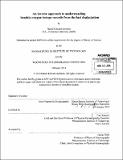| dc.contributor.advisor | Carl Wunsch. | en_US |
| dc.contributor.author | Amrhein, Daniel Edward | en_US |
| dc.contributor.other | Woods Hole Oceanographic Institution. | en_US |
| dc.date.accessioned | 2014-05-23T19:39:25Z | |
| dc.date.available | 2014-05-23T19:39:25Z | |
| dc.date.copyright | 2014 | en_US |
| dc.date.issued | 2014 | en_US |
| dc.identifier.uri | http://hdl.handle.net/1721.1/87507 | |
| dc.description | Thesis: S.M., Joint Program in Oceanography (Massachusetts Institute of Technology, Department of Earth, Atmospheric, and Planetary Sciences; and the Woods Hole Oceanographic Institution), 2014. | en_US |
| dc.description | Cataloged from PDF version of thesis. | en_US |
| dc.description | Includes bibliographical references (pages 139-148). | en_US |
| dc.description.abstract | Observations suggest that during the last deglaciation (roughly 20,000-10,000 years ago) the Earth warmed substantially, global sea level rose approximately 100 meters in response to melting ice sheets and glaciers, and atmospheric concentrations of carbon dioxide increased. This interval may provide an analog for the evolution of future climate. The ocean plays a key role in the modern climate system by storing and transporting heat, salt, and nutrients, but its role during the last deglaciation remains uncertain. Prominent signals of the last deglaciation in the ocean are a gradual warming and a decrease of the seawater oxygen isotope ratio 5180 (a signature of melting land ice sheets). These changes do not occur uniformly in the ocean, but propagate like plumes of dye over hundreds and thousands of years, the aggregate results of turbulent advective and diffusive processes. Information about changing temperatures and oxygen isotopes is stored in the shells of benthic organisms recovered in ocean sediment cores. This thesis develops and applies an inverse framework for understanding deglacial oxygen isotope records derived from sediment cores in terms of the Green functions of ocean tracer transport and ocean mixed layer boundary conditions. Singular value decomposition is used to find a solution for global mixed layer tracer concentration histories that is constrained by eight last-deglacial sediment core records and a model of the modern ocean tracer transport. The solution reflects the resolving power of the data, which is highest at model surface locations associated with large rates of volume flux into the deep ocean. The limited data resolution is quantified and rationalized through analyses of simple models. The destruction of information contained in tracers is a generic feature of advective-diffusive systems. Quantifying limitations of tracer records is important for making and understanding inferences about the long-term evolution of the ocean. | en_US |
| dc.description.statementofresponsibility | by Daniel Edward Amrhein. | en_US |
| dc.format.extent | 148 pages | en_US |
| dc.language.iso | eng | en_US |
| dc.publisher | Massachusetts Institute of Technology | en_US |
| dc.rights | M.I.T. theses are protected by copyright. They may be viewed from this source for any purpose, but reproduction or distribution in any format is prohibited without written permission. See provided URL for inquiries about permission. | en_US |
| dc.rights.uri | http://dspace.mit.edu/handle/1721.1/7582 | en_US |
| dc.subject | Joint Program in Oceanography. | en_US |
| dc.subject | Earth, Atmospheric, and Planetary Sciences. | en_US |
| dc.subject | Woods Hole Oceanographic Institution. | en_US |
| dc.title | An inverse approach to understanding benthic oxygen isotope records from the last deglaciation | en_US |
| dc.type | Thesis | en_US |
| dc.description.degree | S.M. | en_US |
| dc.contributor.department | Joint Program in Oceanography | en_US |
| dc.contributor.department | Woods Hole Oceanographic Institution | en_US |
| dc.contributor.department | Massachusetts Institute of Technology. Department of Earth, Atmospheric, and Planetary Sciences | |
| dc.identifier.oclc | 879669077 | en_US |
